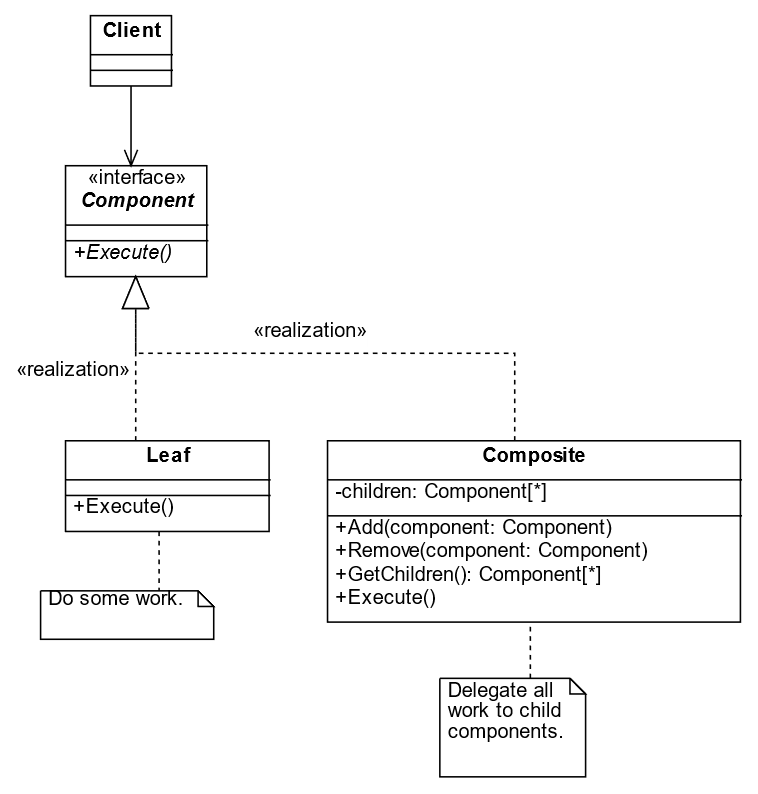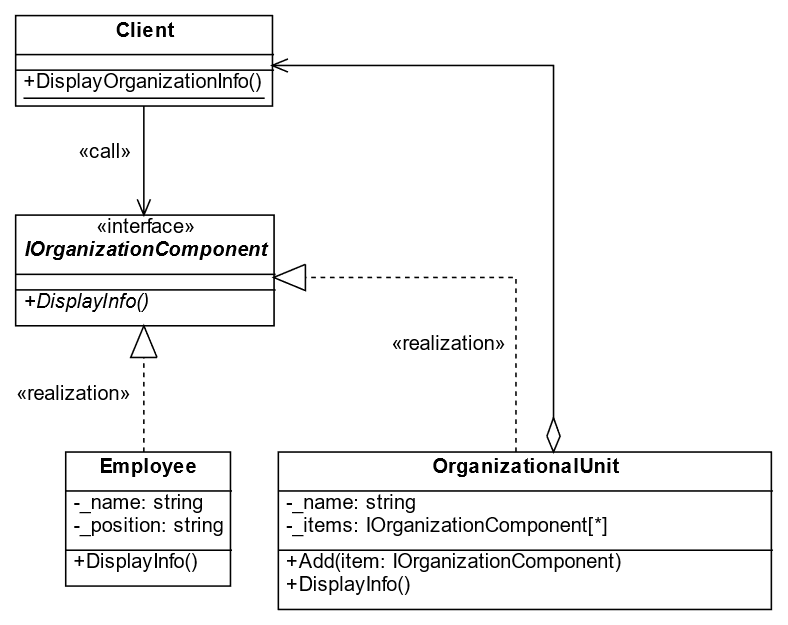Composite is a structural design pattern that allows us to treat individual objects and compositions of objects uniformly. This pattern is especially useful when dealing with hierarchical structures, such as a tree of objects, where we need to work with individual objects as well as collections of objects in a consistent manner.
How does the Composite Design Pattern work?
The key idea behind the Composite Design Pattern is to create a common interface or base class that both Leaf objects (individual objects) and Composite objects (collections of objects) implement.
This common interface, or Component, defines operations that may be performed on both types of objects, allowing clients to treat them interchangeably.
A Leaf is a concrete implementation of the Component interface. It represents individual objects that do not have any children. In the context of a tree structure, leaves are the end nodes. Usually, Leaf components end up doing most of the real work since they do not have anyone to delegate the work to.
A Composite is also a concrete implementation of the Component interface, but it can hold child components. It can be used to represent complex objects that are composed of smaller objects or other Composites. It implements operations that manipulate its children, which can be Leaves or other Composites. When a request is received, a Composite delegates work to its sub-elements, processes intermediate results, and then returns the result to the Client.

Now, let’s take a look at a real world inspired example: we’ll model an organization’s hierarchical structure, which includes organizational units and employees.

The OrganizationalUnit class is a container that can comprise any number of Employees, and other OrganizationalUnits. An OrganizationalUnit and a simple Employee implements the same methods (declared in IOrganizationComponent). However, instead of doing something on its own, an OrganizationalUnit passes the request recursively to all its children and “sums up” the result.
The Client code works with all components (IOrganizationComponent) through the single interface common to all of them. Thus, the Client doesn’t know whether it’s working with a simple component or a compound one. The Client can work with very complex object structures without being coupled to concrete classes that form that structure.
The source code for the presented sample is available on GitHub.
Advantages of the Composite Design Pattern
The Composite Design Pattern offers several advantages when it comes to designing and managing complex hierarchical structures of objects in your software applications:
- Uniformity: One of the primary advantages is that it allows us to treat both individual objects and compositions of objects uniformly. This simplifies client code, as it doesn’t need to distinguish between leaf and composite
- Hierarchical Structures: It is particularly useful when dealing with hierarchical structures, such as trees or organizational hierarchies. We can represent complex structures in a way that is easy to understand and work with.
- Simplified Client Code: Client code becomes more straightforward because it interacts with a single interface or abstract class, regardless of whether it’s working with a single object or a complex composition of objects. This reduces the complexity of client code.
- Scalability: We can easily add new types of components (leaves or composites) to the hierarchy without changing existing code. This makes our code more extensible and scalable.
- Complex Operations: It enables us to define complex operations that can be applied to the entire hierarchy. These operations can be implemented recursively, making it easier to work with deeply nested structures.
- Encapsulation: The Composite pattern promotes Encapsulation by encapsulating the individual objects (leaves) and their compositions (composites) within a common interface. This can help hide the internal structure of the objects from clients.
- Maintenance and Refactoring: It simplifies maintenance and refactoring efforts. We can modify the structure or behavior of individual components or the entire hierarchy without affecting the Client’s code.
- Reuse: Components can be reused in different parts of the application, which promotes code reuse and modularity.
- Clear Abstraction: The pattern provides a clear abstraction for building complex structures, making the code more understandable and maintainable.
- Composite Integrity: It ensures that the integrity of the composite structure is maintained. Operations applied to a composite object can be automatically propagated to its child components.
- Client Flexibility: Clients have the flexibility to work with individual components or with the entire hierarchy, depending on their needs. This flexibility can simplify the design of user interfaces and interactions.
Disadvantages of the Composite Design Pattern
While the Composite Design Pattern offers several advantages, it also has some potential disadvantages and considerations to keep in mind:
- Complexity: While the pattern simplifies client code, it can introduce complexity in the implementation of composite objects (composites) that need to manage a list of child components. This complexity can make the code harder to maintain.
- Performance Overhead: Managing a hierarchy of objects, especially large ones, may introduce performance overhead due to the recursive nature of operations on composite objects. Depending on the use case, this overhead may not be acceptable.
- Type Safety: The pattern uses a common interface or abstract class to represent both leaf and composite This can lead to a lack of type safety, as Clients may attempt operations that are only meaningful for one type of object. Runtime checks may be needed to ensure type safety.
- Limited Leaf Customization: If individual leaf objects have unique properties or behaviors, the Composite pattern may not be the best choice, as it enforces a uniform interface across all components. In such cases, you may need to resort to other patterns or adaptations.
- Memory Consumption: Storing a hierarchy of objects can consume memory, especially if the hierarchy is deep or if there are many objects involved. This can be a concern in resource-constrained environments.
- Difficulties with Removal: Removing or deleting specific components from a composite can be tricky, especially when other parts of the code are relying on the existence of those components.
- Limited Support for Unrelated Operations: It can be challenging to support operations that are unrelated to the composite structure itself. Adding such operations may not fit naturally within the pattern and may require workarounds.
- Initial Design Complexity: Introducing the Composite pattern from the beginning of a project when the hierarchy is simple may introduce unnecessary complexity. It’s often best suited for situations where you anticipate the need for complex hierarchies in the future.
- Learning Curve: Developers who are not familiar with the Composite pattern may need time to understand and adapt to its concepts, which could potentially slow down development initially.
- Potential Misuse: Like any design pattern, the Composite pattern can be misused. It’s essential to apply it when it genuinely fits the problem domain and structure of your objects.
When should we use the Composite Design Pattern?
The Composite Design Pattern should be used when we have a part-whole hierarchy or a tree-like structure of objects and we want to treat individual objects and compositions of objects uniformly. Here are some scenarios in which we should consider using the Composite Design Pattern:
- Hierarchical Structures: Use the Composite pattern when we need to represent hierarchical structures like trees, directories, menus, organizational hierarchies, or any structure where objects can be composed of other objects.
- Recursive Operations: When we have to perform operations on a hierarchy of objects in a recursive manner, the Composite pattern is a suitable choice. It simplifies the recursive traversal and application of operations.
- Uniformity: If we want to provide a consistent interface for both individual objects and composite objects, use the Composite This uniformity simplifies client code, as it doesn’t need to distinguish between the two.
- Flexibility: When we want Clients to be able to work with objects at various levels of the hierarchy, from individual leaves to entire compositions, the Composite pattern provides this flexibility.
- Dynamic Structure: If our structure is dynamic and we need to add or remove objects at runtime without affecting Client code, the Composite pattern supports this.
Real-world examples of Composite Design Pattern
The Composite Design Pattern is widely used in real-world software development across various domains. Here are some real-world examples where we can find the application of the Composite Design Pattern:
- Graphic Design Software: In graphic design applications like Adobe Photoshop or Illustrator, graphical elements like shapes, lines, and text can be composed into complex designs. The Composite pattern is used to represent these elements and the ability to group them into more complex structures.
- File Systems: Operating systems often use the Composite pattern to represent files and directories. Directories can contain files or other directories, creating a hierarchical structure that can be navigated and manipulated uniformly.
- User Interface (UI) Frameworks: UI frameworks like Windows Presentation Foundation (WPF) and JavaFX use the Composite pattern extensively. UI elements, such as buttons, labels, and panels, can be composed into complex layouts and containers.
- Document Editors: Text editors or document editors like Microsoft Word use the Composite pattern to represent documents. Documents contain sections, paragraphs, and text, which can be structured hierarchically.
- Web Page Layouts: When designing web pages using HTML and CSS, the Composite pattern is evident. HTML elements can be nested within other elements, creating complex web page layouts. CSS styling rules can be applied to individual elements or groups of elements.
- Organizational Structures: Enterprise software often models organizational structures, including departments, teams, and employees. The Composite pattern is used to represent the hierarchy of organizational units and employees within them.
- Menu Systems: In graphical user interfaces, menu systems can be implemented using the Composite Menus can contain individual menu items or sub-menus, allowing for nested structures.
- Drawing and CAD Applications: Drawing applications and Computer-Aided Design (CAD) software use the Composite pattern to represent objects on a canvas. Shapes, lines, and other elements can be composed into complex drawings.
- Billing and Invoicing Systems: Billing and invoicing systems may have complex billing structures. The Composite pattern can be used to represent invoices with line items, where line items can be individual charges or sub-invoices.
- Financial Modeling: Financial applications may represent complex financial instruments or portfolios. The Composite pattern can be applied to represent these structures, allowing for consistent operations on individual financial instruments and portfolios.
These real-world examples demonstrate the versatility of the Composite Design Pattern in various domains, where hierarchical structures of objects need to be managed and manipulated in a unified and scalable manner.
Conclusion
Overall, the Composite Design Pattern is a powerful tool for managing complex structures in a way that is both flexible and maintainable, making it especially valuable in scenarios where hierarchical relationships are prevalent. Despite its potential disadvantages, the Composite Design Pattern remains a valuable tool when dealing with hierarchical structures in software. When deciding whether to use this pattern in a given context, careful consideration of the specific requirements and trade-offs is required, as it may introduce some complexities, particularly in smaller and simpler scenarios where it may be overkill.








